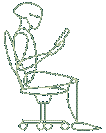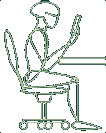One must always be mindful to play Tetris in an environment conducive to mental alertness and overall eye-hand coordination. Perhaps following these tips will improve your performance. (Keep in mind that I have absolutely no medical expertise whatsoever - just Tetris experience - so take these tips, along with the others, with a grain of salt.)
First, I recommend that Tetris should be played in a chair (or couch, if need be). There are multiple positions that have been tried time and time again, but I have found sitting produces the most consistent results.

This is arguably the most ideal position. I've felt slight fatigue build up in my neck and wrists (upon which I promptly rest, usually in front of a TV), yet my lower back feels pretty good here.

Sitting before a desk provides some comfort to your wrists, yet you place your back in jeopardy by keeping yourself in such a taut form. Only if all available light is localized within one desk lamp should this position be necessary. Also, if the edges of your desk aren't beveled or curved, you may get a painful crease on the underside of your forearms. I have a hypothesis that eventually your radii and ulna will snap into halves if enough of that type of pressure is placed on them.

The non-conformist approach - very casual, but possibly painful. This position may provide temporary relief to your legs, but your upper body will suffer gladly. Your neck is twisted upward in an awkward position, your back tires very quickly, unnecessary pressure is placed upon your stomach, and your elbows face the brunt of the impact. (This is especially noticable when you play on shag carpets, as opposed to your bed; you get seemingly permanent kitsch patterns imprinted on your elbows.) Even more disheartening is the lack of dexterity, for only your forearms are mobile. Men may face additional discomfort being in this position for a long time, much like riding a bicycle....

The even distribution of weight on one's back and neck can be quite refreshing (often the beleaguered non-conformist will switch to this position after being in the previous one for a while). However, your arms are completely up in the air - instant fatigue. Also, performing lying on ones back may result in drowsiness, and eventually 'book-head' (a common affliction in which one falls asleep reading a book, the arms fall to the bed, and the book hits the person right in the face - that might be how my nose got the way it is now... stupid Fountainhead....) Anyway, I could only imagine that 'Gameboy-head' would be even more painful.

